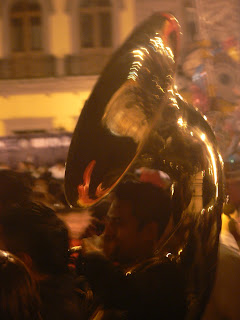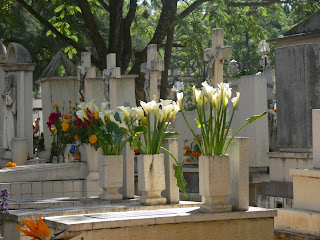Dia de Muertos is a celebration that actually spans two days, starting on Nov. 1 and continuing through Nov. 2. Apparently, Halloween is becoming more and more festive here, but the main days, when the traditional Day of the Dead activities take place, are still the two in November. In a way, this is a strange holiday to be a tourist for. Clearly, this a touristy time to visit - all week, as the holiday approached, there were more and more visitors in the city - and the economy benefits from the draw of the various showy aspects of these special days. But it is also an intensely personal and family-centered holiday, the most important aspects of which, for many Oaxacans, takes place behind closed doors.
The basis of the celebration, is the belief of many Mexicans that the souls of departed friends and relatives return to their homes and graves on November 2. In order to welcome these spirits and encourage them to resume their path towards heaven, families construct altars with food, drink, flowers and keepsakes and photos of the deceased. Traditionally, altars have three levels - a lower for earth, a middle for Purgatory, and an upper for heaven - although the altars we saw often had only two, or even just one, level. Still, the elements of food, photos and flowers were common to almost every one, with oranges, the small orange flowers Erica picked at Calpulli, and Pan de los Muertos having great prominence. Turkey is also, according to Sonia, a near essential element for many families' altars, which is why so many were being sold in the Zaachila market we visited together.
Here's a very fancy altar in one of the artisan shops.
Some altars are constructed in cemeteries, and others in public places - a soccer player was honored, for example, in the plaza behind us (pictured below) - but most are inside homes, and this is where the heart of Dia de Muertos seems to take place.

Family and friends gather together to remember their lost loved ones, to laugh and cry and simply be together for a day in honor of those who have died. So, again, it was interesting to be here for these days, but also, what we did see was perhaps not entirely indicative of the true meaning of the holiday.
We did, however, enjoy the sights, sounds and tastes of the celebration. On Sunday, along with an ever-growing crowd, we joined a battle-of-the-bands parade that was passing by our front door. There were two brass bands, who took turns playing lively tunes, with lengthy stops at every street corner.
We followed the party as far as the Zocalo, where it stopped again for a time, then watched the revelers wind away to the south. The music was great, and leading the pack were two very entertaining goblins who danced until they were tired, then hitched piggy-back rides until they were ready to dance again. They were moving so much and the crowd was so big, it was really hard to snap a good photo...
In the Zocalo itself, various teams - most seemed to be made up of teenagers - had spent the better part of two days constructing enormous sand sculptures of skeletons, demons and variuos other scary creatures. Very neat. Usually the Zocalo also features an enormous altar in front of the Palacio de Gobierno, but that spot is currently occupied by protestors from the 2006 APO uprising, so no altar was built this year.
On Monday, we wandered over to the Centro de Aprendizaje to meet up with Jorge and another guest staying there, before joining our second impromptu parade. This procession was a bit older with only a single band, and the leader was both determined and serious.
We stayed with them for a few blocks before veering north towards the Panteon General, the main cemetery in Oaxaca. Here, the surrounding streets were packed with vendors, food stands and even some carnival rides. And inside, the entire cemetery was lit with candles. It was crowded but also peaceful. The picture below shows the crypts lining the entirety of the outer walls, each of which had at least one votive, and which provided the only light in an otherwise dark night.
On Tuesday (Nov. 2) we ventured back to the Panteon General to try some of the food and get a glimpse of the cemetery during the day. Outside the atmosphere was as festive as the night before and the food was great - molotes, a fried pocket of chorizo and potato, are a new favorite for me - but inside the cemetery was comparatively empty and many of the altars and displays from the night before had already been taken down. Still, we did see some families gathered around graves and the miniature mausoleums that fill the cemetery to bursting, which gave us a nice sense of the more intimate aspects of the holiday.
Aside from the many temporary vendors that have sprung up in unusual places, a final striking aspect of the festival has been the skulls on Alcala. Something akin to Cows on Parade in Chicago or the orcas in Vancouver, the tourist walkway has been lined with enormous papier mache skulls, each decorated uniquely by a local artist.












No comments:
Post a Comment